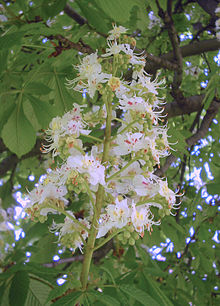| Aesculus | |
|---|---|

| |
| Aesculus hippocastanum, the European horse chestnut | |
| Scientific classification | |
| Kingdom: | Plantae |
| Clade: | Tracheophytes |
| Clade: | Angiosperms |
| Clade: | Eudicots |
| Clade: | Rosids |
| Order: | Sapindales |
| Family: | Sapindaceae |
| Subfamily: | Hippocastanoideae |
| Genus: | Aesculus L. |
| Type species | |
| Aesculus hippocastanum | |
| Species | |
| |



The genus Aesculus (/ˈɛskjʊləs/[1] or /ˈaɪskjʊləs/), with species called buckeye and horse chestnut, comprises 13–19 species of flowering plants in the family Sapindaceae. They are trees and shrubs native to the temperate Northern Hemisphere, with six species native to North America and seven to 13 species native to Eurasia. Several hybrids occur. Aesculus exhibits a classical Arcto-Tertiary distribution.[a]
Mexican buckeye seedpods resemble the Aesculus seedpods, but belong to a different genus.
Carl Linnaeus named the genus Aesculus after the Roman name for an edible acorn. Common names for these trees include "buckeye" and "horse chestnut", though they are not in the same order as the true chestnuts, Castanea in the Fagales. Some are also called white chestnut or red chestnut. In Britain, they are sometimes called conker trees because of their link with the game of conkers, played with the seeds, also called conkers.
- ^ Cite error: The named reference
sunsetwas invoked but never defined (see the help page). - ^ Ogg, J.G.; Gradstein, F.M.; Gradstein, F.M. (2004). A geologic time scale 2004. Cambridge, UK: Cambridge University Press. ISBN 978-0-521-78142-8.
Cite error: There are <ref group=lower-alpha> tags or {{efn}} templates on this page, but the references will not show without a {{reflist|group=lower-alpha}} template or {{notelist}} template (see the help page).